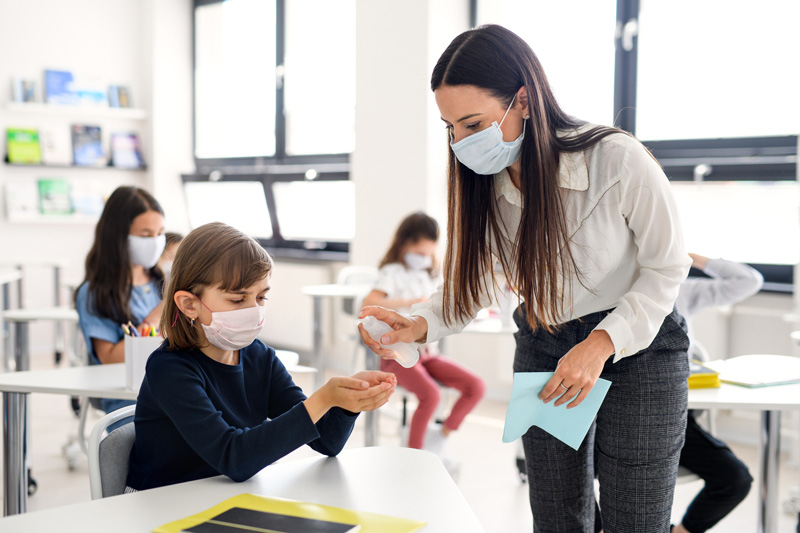
Keeping Schools Clean during COVID-19 – Checklist
COVID Classroom Cleaning Checklist
Thankfully, government data shows that the transmission of COVID-19 in schools remains low, but to keep the risk reduced, conduct a COVID cleaning routine for your school. Completing a classroom cleaning checklist ensures all key areas are clean and hygienic, so students can focus and enjoy learning and teachers can teach.
Wipe Down Surfaces
Touch surfaces are a vector for coronavirus transmission that’s simple to mitigate against. Asking students to sanitise their hands regularly and to not unnecessarily touch their mouths prevents droplets of coronavirus from spreading across the classroom and the school. Unfortunately, however, infectious droplets may still turn up on surfaces, especially frequent touch points such as door handles.
Make sure you clean and sanitise high-volume touch surfaces regularly, once per day at a minimum. If possible, this cleaning task is most effective when done throughout the school day; don’t think once a week is enough to tick this off your classroom cleaning checklist.
Touch surfaces include any area that’s frequently touched. Door handles, window ledges, and table surfaces are touched by many people throughout the day. Whiteboards and computers are other examples that may be shared, which could lead to the transmission of COVID-19. Reduce the risk by wiping these surfaces down regularly, for items like computer keyboards it’s smart to clean them after every use.
Unfortunately, COVID-19 transmission cannot only be prevented by wiping down touch surfaces. If a student or teacher has tested positive for coronavirus, you need to call in professional cleaners who specialise in the decontamination of COVID-19. They can not only verify all regularly used touch points are decontaminated with ATP swabs and quat testing but eliminate airborne respiratory droplets using ULV fogging.
Mop Floors
Every teacher knows the pain of a classroom of children’s shoes spreading mud across the floor. Whether it’s the corridor or the classroom, muddy footprints from the playground accumulate on the flooring throughout the day. Litter and general debris also pile up without a school cleaning plan.
Always include mopping floors as part of your school cleaning checklist. Now, however, it’s also an essential task to reduce the risk of COVID transmission. Some infectious disease specialists have warned that COVID-19 droplets can survive on shoes for up to 5 days. While it’s a low-risk form of transmission, mopping the school’s floors is a smart precaution to take that keeps your school hygienic and clean at the same time.
Clean Desks & Tables
One of the most touched surfaces in any school will be the desks and tables. It’s where children write, learn, and sit throughout the day. They go through lots of wear and tear in one school day, let alone an entire academic year, so any school cleaning checklist needs to include regular desk cleaning.
The first step for cleaning any school desk is removing litter and waste that’s been left on the surface. From there, wipe it down thoroughly to prevent staining, but also to clear away any lingering infectious droplets. Unfortunately, as every teacher knows, the underside of a desk or table needs cleaning as well. Chewing gum and any other sticky substance could be left beneath a desk and needs to be removed.
Removing chewing gum from beneath a desk or table requires specialist school cleaning services. While it may sound simple, the process needs skill, the right tools, and appropriate cleaning products. Attempting to do it yourself could damage the furniture and it will be extremely difficult to remove every part of the chewing gum.
Specialist Carpet Cleaning
A cleaning checklist for schools doesn’t only improve hygiene in the classroom but is a form of maintenance as well. Carpet cleaning is a great example of this as the process extends the life of your school’s carpet. Any carpet can become home to dust particles, bacteria, and chewing gum, especially in schools. With specialist cleaning, your school’s staff members can ensure that these elements are removed without damaging the carpet.
Contaminants often found in carpets can cause respiratory problems. Hoovering does remove dirt, dust, and other contaminants; however, it doesn’t get rid of all of them. While you should hoover the school’s carpets every day, make sure you book regular specialist carpet cleaning. This ensures all contaminants are removed safely and helps your carpet retain its quality over time.
Empty Bins Regularly
Keep your classroom tidy and free from unpleasant odours by emptying bins regularly. When you allow rubbish to pile up in bins, this leads to waste falling onto the floor. Across the school, there will be bins in classrooms, corridors, and in the playground. Make sure you manage all waste disposal areas to ensure bins never overflow. Recycling bins also help your school be greener and more sustainable and shouldn’t be left to pile up either.
As part of your school cleaning checklist, make sure that emptying bins is a regular task. To reduce the transmission of coronavirus, this task takes on added importance. When students or teachers dispose of waste, infectious droplets may be on the materials’ surfaces. Emptying bins regularly reduces the risk of these hazardous materials coming into contact with people.
LCS School Cleaning
Healthy, productive students need a hygienic learning environment to be the best they can be. A clean classroom also helps teachers run lessons and makes the day more enjoyable for everyone. A thorough cleaning routine is essential for primary, secondary schools, and sixth forms. In current times, however, keeping your school clean is more important than ever.
While many tasks on your COVID cleaning checklist for schools can be completed yourself, some require cleaning professionals. Learn about specialist school cleaning services, get in touch with LCS.